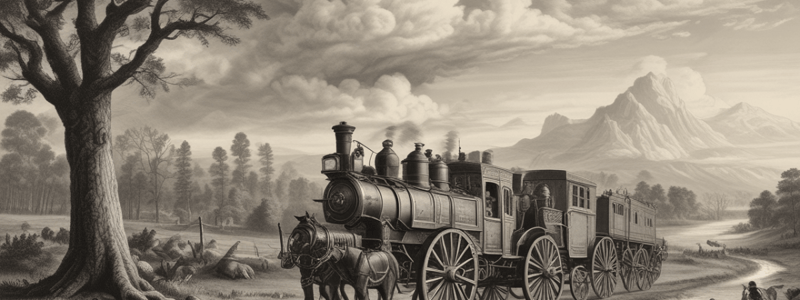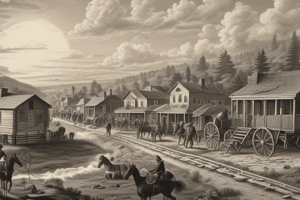Podcast
Questions and Answers
What was the primary source of labor in the Southern states' agricultural economy?
What was the primary source of labor in the Southern states' agricultural economy?
- Indentured servants and migrants
- Slaves and sharecroppers (correct)
- Mercenaries and adventurers
- Small farmers and artisans
Why did Western states seek an alliance with Southern states?
Why did Western states seek an alliance with Southern states?
- To expand the reach of steamboats and railroads
- To reduce the cost of government land and lower protective tariffs (correct)
- To limit the power of the federal government
- To promote the interests of industrialists and bankers
What was the primary concern of Northern states regarding tariffs?
What was the primary concern of Northern states regarding tariffs?
- They wanted lower tariffs to increase trade
- They opposed tariffs altogether
- They were indifferent to tariffs
- They wanted higher tariffs to protect American industries (correct)
How did President Jackson approach sectional tensions at first?
How did President Jackson approach sectional tensions at first?
What was the main difference between the economies of the North and South?
What was the main difference between the economies of the North and South?
What was the main goal of Western states in expanding their economy?
What was the main goal of Western states in expanding their economy?
What was the early rift between the North, South, and West caused by?
What was the early rift between the North, South, and West caused by?
What was the main issue that bothered the nullifiers?
What was the main issue that bothered the nullifiers?
What was Calhoun's proposal for dealing with federal laws?
What was Calhoun's proposal for dealing with federal laws?
What was the result of the Nullification Crisis?
What was the result of the Nullification Crisis?
What was the underlying fear of Southern states regarding the federal government?
What was the underlying fear of Southern states regarding the federal government?
What did President Jackson threaten to do to those who defied federal law?
What did President Jackson threaten to do to those who defied federal law?
Why did Calhoun resign as Vice President?
Why did Calhoun resign as Vice President?
What was the ratio of slaves to whites in parts of South Carolina?
What was the ratio of slaves to whites in parts of South Carolina?
What was the outcome of South Carolina's ordinance of nullification?
What was the outcome of South Carolina's ordinance of nullification?
Flashcards are hidden until you start studying
Study Notes
Sectional Differences in the U.S.
- The young U.S. faced sectional tensions due to differing economies in the North, South, and West.
- The Northern states had a heavy industry and capital base, while the South's economy was primarily based on agriculture, slave labor, sharecroppers, and a small but powerful landed gentry.
- The Western states, like the South, had economies built on agriculture and raw materials, and needed to expand to grow economically.
Tariffs and Land Disputes
- The Western states sought an alliance with the South to reduce the cost of government land and lower protective tariffs.
- Northern interests opposed this, seeing protective tariffs as necessary to raise revenue and protect America's young industrial base.
- This disagreement over tariffs and land was an early rift between the North, South, and West.
The Nullification Crisis
- The nullification crisis, sparked by John C. Calhoun, was an early rift between the interests of the North, South, and West.
- Calhoun believed that states had the right to declare null and void any federal mandate they did not wish to follow.
- This idea would allow states to interpret the Constitution as they saw fit, like any social contract.
Jackson vs. Calhoun on States' Rights
- President Jackson and Calhoun disagreed on states' rights, with Jackson believing that if any state could nullify federal law, there would be no union.
- Jackson threatened to hang anyone who defied federal law, stating that if one drop of blood was shed, he would take action.
- Calhoun believed that if a state disagreed with a federal law, it had the right to refuse to obey it or withdraw from the social contract altogether.
The South Carolina Nullification Ordinance
- In November 1832, South Carolina passed an ordinance of nullification, refusing to obey federal tariffs and giving the state legislature the power to raise an army.
- Jackson acted immediately, threatening to send troops if necessary and punish any act of treason.
The Crisis Resolution
- Calhoun resigned as Vice President and returned to the Senate, seeking to control the crisis.
- A compromise tariff bill was passed, promising to lower tariffs over a period of ten years.
- Southern radicals knew Jackson was serious about military actions, and cooler heads prevailed, at least temporarily.
Studying That Suits You
Use AI to generate personalized quizzes and flashcards to suit your learning preferences.




